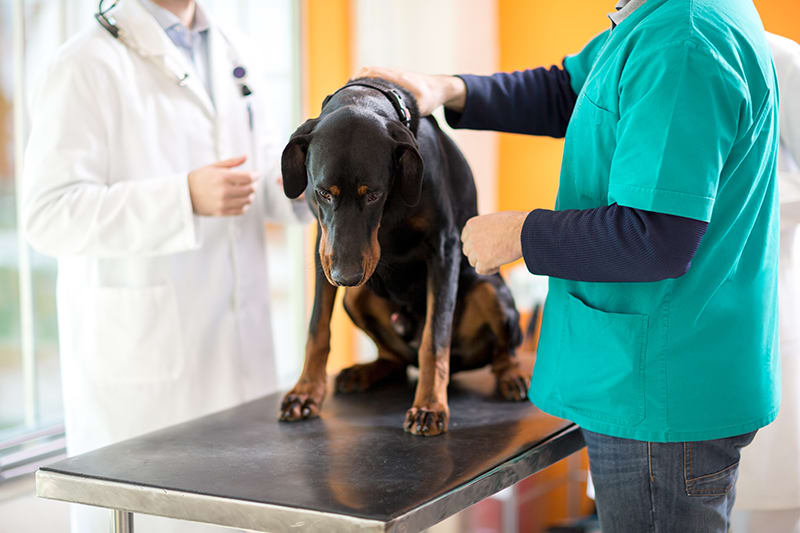Pet Care
Pancreatic Cancer in Dogs
2 Roles of Your Dog’s Pancreas
Your pup’s pancreas is located near the start of your dog’s small intestine and performs two essential functions.
Pancreatic Exocrine Cells
- The exocrine cells within your dog’s pancreas work to produce enzymes that help to digest food.
Pancreatic Endocrine Cells
- The endocrine cells are responsible for the production of insulin and other hormones which either directly or indirectly affect the functioning of almost every organ in your dog’s body.
Symptoms of Pancreatic Cancer in Dogs
If your dog is diagnosed as having a pancreatic tumor it means that the cells within a specific part of your pup’s pancreas are overproducing (reproducing excessively). As with most tumors in animals and people, your dog’s pancreatic tumor could be either benign (non-cancerous) or malignant (cancerous).
Sadly, in dogs malignant pancreatic tumors are more common than benign, however, both are relatively rare. The most common form of pancreatic cancer seen in dogs is insulinoma, followed by adenocarcinoma.
The different forms of pancreatic cancer in dogs will produce a host of different symptoms. If your dog is displaying any of the symptoms listed below it’s important to get your pup to the vet for an examination as soon as possible.
Insulinomas
Insulinoma tumors lead to the excessive production of insulin when there is no food in the stomach to trigger its normal release into the bloodstream. As a result of the unnecessary insulin, blood sugar levels are reduced and your pet will experience symptoms such as:
- Reduced energy
- Lack of enthusiasm for exercise
- Fainting after prolonged periods without food
- Lack of coordination
- Confusion
- Muscle twitching
- Seizures
Adenocarcinomas
Because the early signs of adenocarcinomas in dogs are vague this form of pancreatic cancer is rarely diagnosed until the disease has progressed.
Symptoms of adenocarcinomas in dogs are much the same as the symptoms of pancreatitis (inflammation of the pancreas) and include:
- Reduced appetite
- Vomiting
- Lack of energy
- Abdominal pain
- Weight loss
- Jaundice
If the cancer has spread to other areas of your dog’s body (which is common with this form of cancer) you may notice symptoms such as breathing difficulties or lameness.
Diagnosing Pancreatic Cancer in Dogs
Pancreatic tumors can be challenging to diagnose. Besides being a relatively rare condition, the symptoms associated with these tumors often come and go. To further complicate the matter these symptoms are also indicative of other more common conditions in dogs.
When you take your dog in for an examination your vet will take the time to ask you questions about your pup’s medical history and do a thorough physical examination.
If your vet suspects that your dog may have pancreatic cancer they may refer you to a Veterinary Oncologist for further testing and treatment or recommend one or more of the following diagnostic tests:
- Blood tests
- Glucose level exams
- Test for hypoglycemia
- X-rays (radiographs)
- CT Scan
- Abdominal ultrasound
- Biopsy
Staging
Pancreatic tumors commonly metastasize (spread to other parts of the body) before the disease is detected and diagnosed in dogs. For that reason, once pancreatic cancer has been diagnosed your vet may wish to do further tests to determine the extent of the disease, if the cancer has spread, and to where.
While it is common for pancreatic cancer in dogs to spread to the nearby liver or lymph nodes it could reach almost any part of the dog’s body including the lungs, bone, or brain. In some cases fluid build-up can be seen in the chest or abdomen causing breathing problems or a swollen abdomen.
Tests that your vet may recommend to determine the ‘stage’ of your dog’s cancer could include:
- Blood tests
- Urinalysis
- Lung X-rays
- CT Scan
- Abdominal ultrasound
Progression of Pancreatic Cancer in Dogs
As well as the very real concern about the cancer spreading to other parts of your pup’s body, there is the issue of damage to the pancreas caused by the growing tumor.
These tumors often lead to chronic inflammation of the pancreas called pancreatitis (which causes symptoms such as hunched back, repeated vomiting, diarrhea, poor appetite, dehydration, weakness and fever), or exocrine pancreatic insufficiency EPI (which causes chronic diarrhea, weight loss and generalized poor health).
Treatment for Pancreatic Cancer in Dogs
In the case of insulinomas, surgery to remove the affected portion of the pancreas, followed by chemotherapy is typically considered the best treatment option. If surgery is not an option your vet may try to manage your dog’s low blood sugar symptoms through a modified diet and feeding plan combined with medications to suppress insulin secretion.
Surgery is also considered to be the most effective treatment for adenocarcinomas although it does come with a very real risk of life-threatening complications. Your pup’s surgeon or veterinary oncologist may remove part of the pancreas or all. In some cases a portion of the small intestine will also be removed. Chemotherapy tends not to be effective in the treatment of adenocarcinomas in dogs.
The Prognosis for Dogs with Pancreatic Cancer
Because pancreatic tumors tend to be malignant there is a high probability that the cancer has spread even before diagnosis has occurred, making the prognosis for dogs with pancreatic cancer poor.
Your vet or veterinary oncologist will be able to provide you with a prognosis for your dog based on the type of tumor and results from staging tests.
Note: The advice provided in this post is intended for informational purposes and does not constitute medical advice regarding pets. For an accurate diagnosis of your pet’s condition, please make an appointment with your vet.
If your dog is showing symptoms of pancreatic cancer contact Animal Hospital of Clemmons right away to book an examination for your pup. Our skilled veterinarians have experience diagnosing and treating cancer in pets.
Looking for a vet in
Clemmons?
We’re always accepting new patients, so contact our veterinary hospital today to book your pet’s first appointment.
Related Articles View All
Puppy Teething Tips for Pet Parents
Our Clemmons vets understand how trying it can be when your puppy starts teething. Teething pain often leads puppies to chew on things they shouldn’t – including your best shoes and furniture. Here are a few tips to help you and your puppy deal with your puppy’s teething.
Dog Grooming 101 – Grooming Different Coat Types
Although all dogs require brushing, bathing and general grooming, some require more care than others. Today our Clemmons pet grooming team explains how to care for dog coats of different textures and lengths.
What To Do About Your Dog’s Stinky Breath
Do you avoid getting close to your pup because their stinky breath is unbearable? Bad breath is common in dogs — especially in senior dogs — and can be a sign of a serious health issue. Our Clemmons vets explain some causes of dog bad breath and how you can help to treat or even prevent it.
Why should I enrol my pet in a Wellness Plan?
If your veterinary clinic offers Pet Wellness Plans you may be curious as to how these plans work and whether they are worth signing up for. Today, our Clemmons vets share 4 benefits to consider when deciding whether a Pet Wellness Plan is right for you and your pet.
Dog Acupuncture & The Conditions It Can Treat
Our Clemmons vets know that if your pet is suffering from a health issue you will want to do all you can to help them feel better. Pet acupuncture can be a noninvasive way to help improve your pet’s rehabilitation. Here’s a bit about how acupuncture for dogs works and when it can be used.







